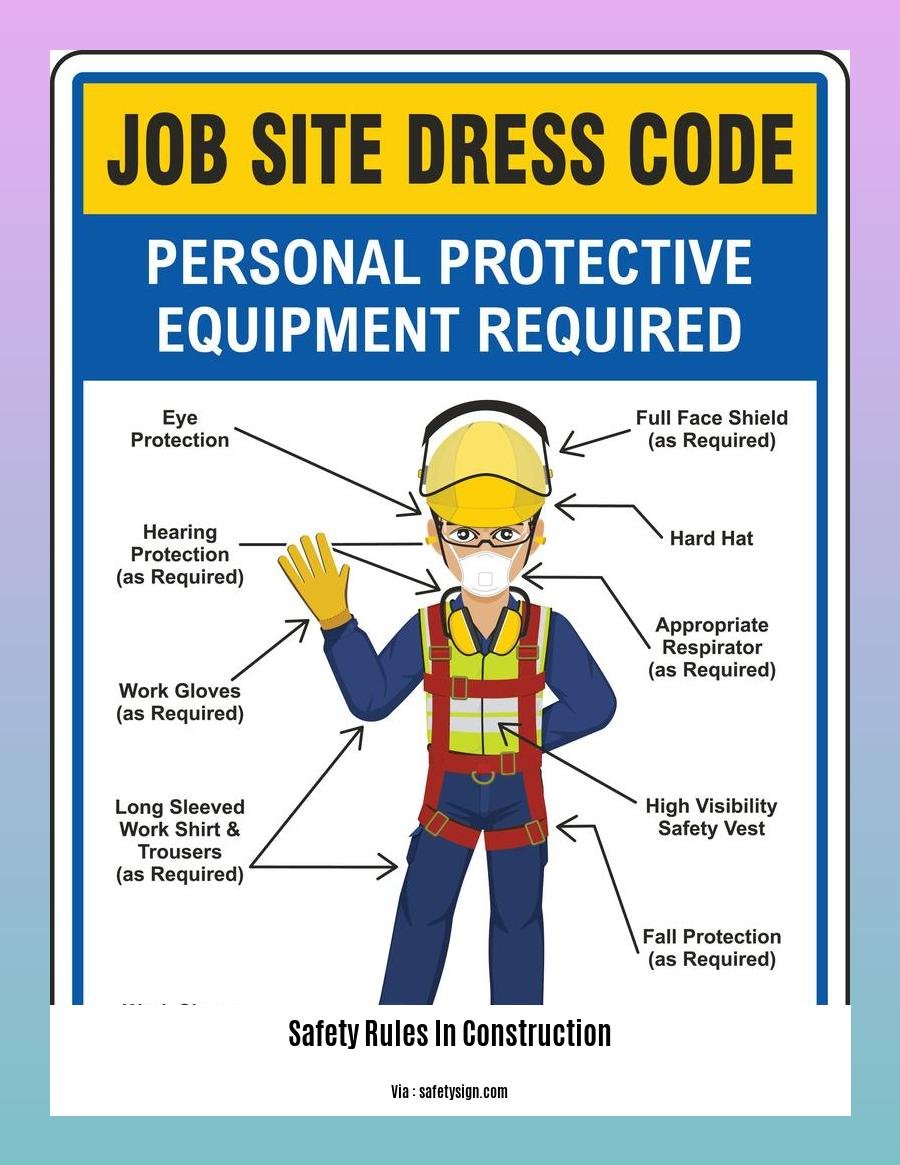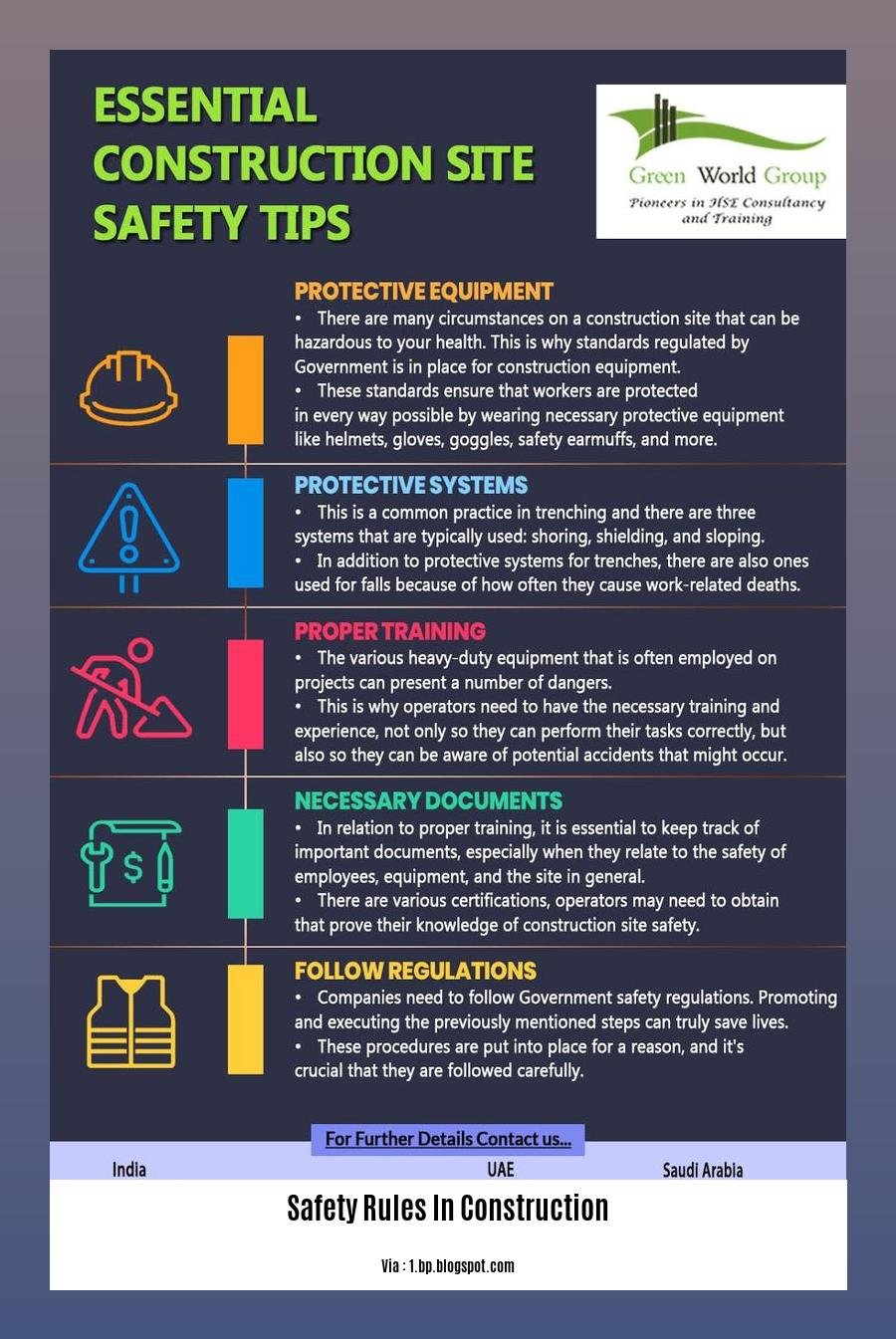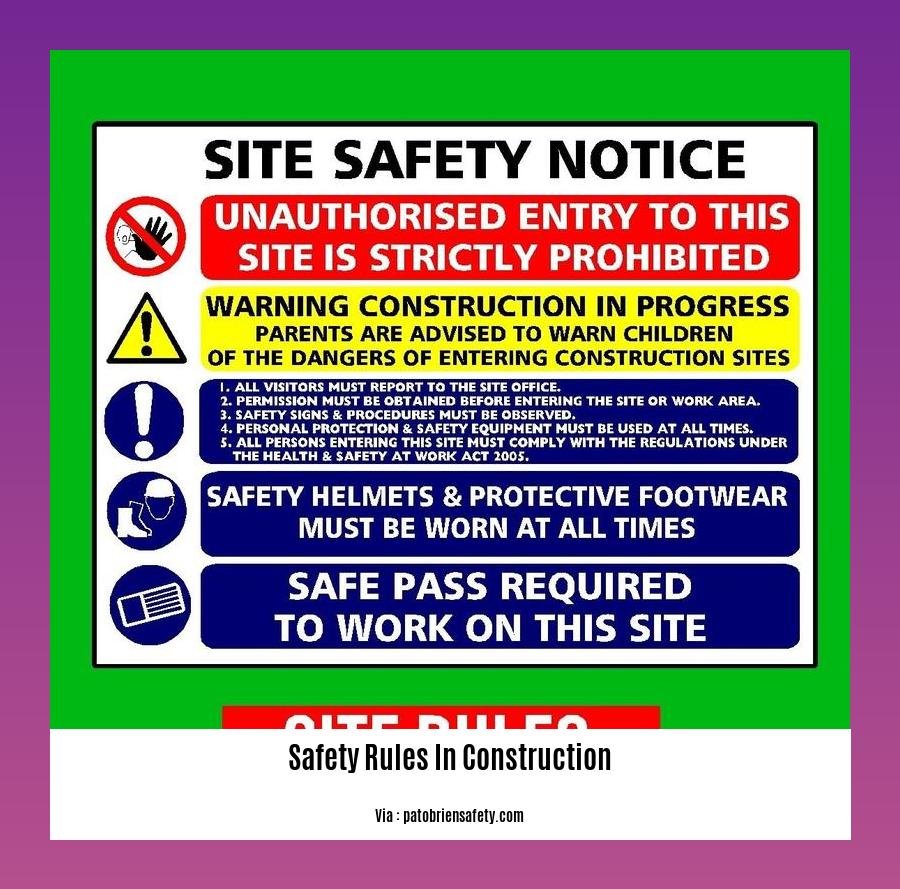[- The Importance of Adhering to Safety Rules in Construction]. Construction sites can be hazardous environments, and it is vital to adhere to safety rules to prevent accidents. Whether you are a seasoned professional or new to the industry, following safety regulations is paramount. This article will explore four critical safety rules that every construction worker must follow: 1. Wear your PPE at all times, 2. Do not start work without an induction, 3. Keep a tidy site, and 4. Do not put yourself or others at risk.
Key Takeaways:
- Wear personal protective equipment (PPE) to minimize exposure to hazards.
- Follow signs and instructions to navigate hazardous areas safely.
- Train employees thoroughly on safety protocols.
- Maintain a tidy worksite to prevent accidents.
- Use appropriate equipment for each task.
- Establish an emergency response plan.
- Set up physical barriers to prevent access to hazardous areas.
- Avoid live electrical systems unless qualified.
- Safeguard trenches and excavations before entering.
- Maintain a distance from electrical lines.
- Inspect scaffolding and tools routinely before use.
Safety Rules in Construction


Ensuring the safety of construction workers and the overall integrity of construction projects rests heavily on adhering to established safety rules in construction. These rules are indispensable guidelines that safeguard individuals from potential hazards and guarantee a secure work environment.
Why are construction safety rules so crucial?
- Prevents Accidents and Injuries: Safety regulations are designed to minimize the risk of accidents, injuries, and fatalities on construction sites by establishing clear guidelines for safe work practices.
- Protects Workers’ Rights: Safety rules ensure that workers are afforded their fundamental right to a safe and healthy workplace, as mandated by law.
- Preserves Equipment and Assets: By following safety protocols, costly damage to equipment and infrastructure can be prevented, safeguarding investments and project timelines.
- Maintains Compliance: Adhering to safety regulations ensures compliance with industry standards and legal requirements, reducing the potential for costly penalties or legal liabilities.
Common Safety Rules in Construction
1. Always Wear Personal Protective Equipment (PPE)
PPE, including helmets, safety glasses, gloves, and other protective clothing, provides an essential layer of protection against hazards like falling objects, debris, and hazardous chemicals.
2. Follow Posted Signs and Instructions
Construction sites can be hazardous, so paying attention to posted signs and instructions is vital for identifying potential risks and taking appropriate precautions.
3. Maintain a Clean and Organized Site
A clean and well-organized site helps prevent slips, trips, and other mishaps. Regularly clearing away debris, securing loose items, and maintaining proper housekeeping practices contribute to a safer environment.
4. Use Proper Equipment for Each Task
Using the correct equipment for each task not only enhances efficiency but also reduces the risk of accidents. Ensure that tools and equipment are in good working condition and used according to the manufacturer’s guidelines.
5. Never Work on Live Electrical Systems
Electrical hazards pose a significant threat on construction sites. Only qualified electricians should perform work on live electrical systems to prevent electrocution or other severe injuries.
6. Barricade and Protect Trenches and Excavations
Unsecured trenches and excavations pose a collapse hazard. Proper safeguards like trench boxes or shoring systems must be in place before entering these areas.
7. Maintain a Safe Distance from Live Electrical Lines
Overhead power lines can be deadly if not handled properly. Always maintain a safe distance and be aware of any potential hazards when working near electrical lines.
8. Inspect Scaffolding Systems Regularly
Scaffolding systems must be inspected daily to ensure stability and prevent collapse. Any defects or damage should be addressed promptly to avoid accidents.
9. Inspect Tools and Equipment Before Use
Defective tools and equipment can be dangerous. Inspect all tools and equipment before each use to identify and address any issues that could compromise safety.
Create an active internal link along with the anchor and URL:
-
Encourage a safe working environment by familiarizing yourself with the safety signs in construction protocols.
-
Enhance safety awareness on construction sites by implementing clear and concise safety signs and symbols.
-
Promote a culture of safety with impactful safety slogans that resonate with construction workers.
3. Keep a tidy site
A well-organized construction site is a safe construction site. Take these steps to keep your site tidy:
- Establish a designated area for waste disposal: This will help to prevent clutter and reduce the risk of accidents. [Citation: haspod.com/blog/construction/good-housekeeping-rules-construction-site]
- Store materials securely: Make sure materials are stacked safely and securely to prevent them from falling and causing injuries. [Citation: clearchoiceuk.com/builders-cleans/housekeeping-ru…]
- Maintain clear access routes: Keep pathways clear of debris and obstacles to prevent tripping and collisions. [Citation: haspod.com/blog/construction/good-housekeeping-rules-construction-site]
- Store tools properly: When not in use, store tools in designated locations to prevent workplace hazards. [Citation: haspod.com/blog/construction/good-housekeeping-rules-construction-site]
- Repair broken items promptly: Address any damaged or out-of-order equipment or materials immediately to prevent further accidents or delays. [Citation: clearchoiceuk.com/builders-cleans/housekeeping-ru…]
- Manage cables neatly: Secure cables neatly to avoid tripping or electrical hazards. [Citation: haspod.com/blog/construction/good-housekeeping-rules-construction-site]
Key Takeaways:
- Establish a designated waste disposal area.
- Store materials securely.
- Maintain clear access routes.
- Store tools properly.
- Repair broken items promptly.
- Manage cables neatly.
4. Do not put yourself or others at risk
Never take actions that could jeopardize your safety or the well-being of your colleagues. Prioritize safety above all else and remain vigilant in identifying and mitigating potential risks.
Key Takeaways:
- Place safety as your top priority.
- Avoid actions that could harm yourself or others.
- Be mindful of your surroundings and potential hazards.
- Report any unsafe conditions or practices immediately.
- Never compromise safety for expedience.
Sources:
- 101 Important Safety Rules in the Workplace – Safety Talk Ideas
- 10 Construction Site Safety Rules to Observe | SafetyCulture
FAQ
Q1: Why are there so many safety rules in construction?
A1: Construction can be a dangerous industry. These rules are in place to help keep workers safe and prevent accidents.
Q2: What are the most important safety rules to follow?
A2: Always wear your personal protective equipment (PPE), including a hard hat, safety glasses, gloves, and safety shoes. Only use tools and equipment that you are trained to use. Never work in an unsafe environment or condition. Always follow the instructions of your supervisor.
Q3: How can I avoid getting hurt on a construction site?
A3: By following the safety rules and being aware of your surroundings. Never walk under a suspended load. Be careful when working with power tools and equipment. Never work on or around live electrical equipment.
Q4: What should I do if I see someone violating a safety rule?
A4: Report it to your supervisor immediately. It is important to speak up if you see someone doing something unsafe. It could help prevent a serious accident.
Q5: What is the employer’s responsibility for safety on a construction site?
A5: The employer is responsible for providing a safe work environment for their employees. This includes providing proper training, equipment, and supervision.
- Embossed Backsplash Tile Kitchen: Add Texture And Style - December 22, 2025
- Ceramic Tile Backsplash Ideas for Your Kitchen Remodel - December 21, 2025
- Contemporary Kitchen Backsplash Ideas for a Stylish Home - December 20, 2025










